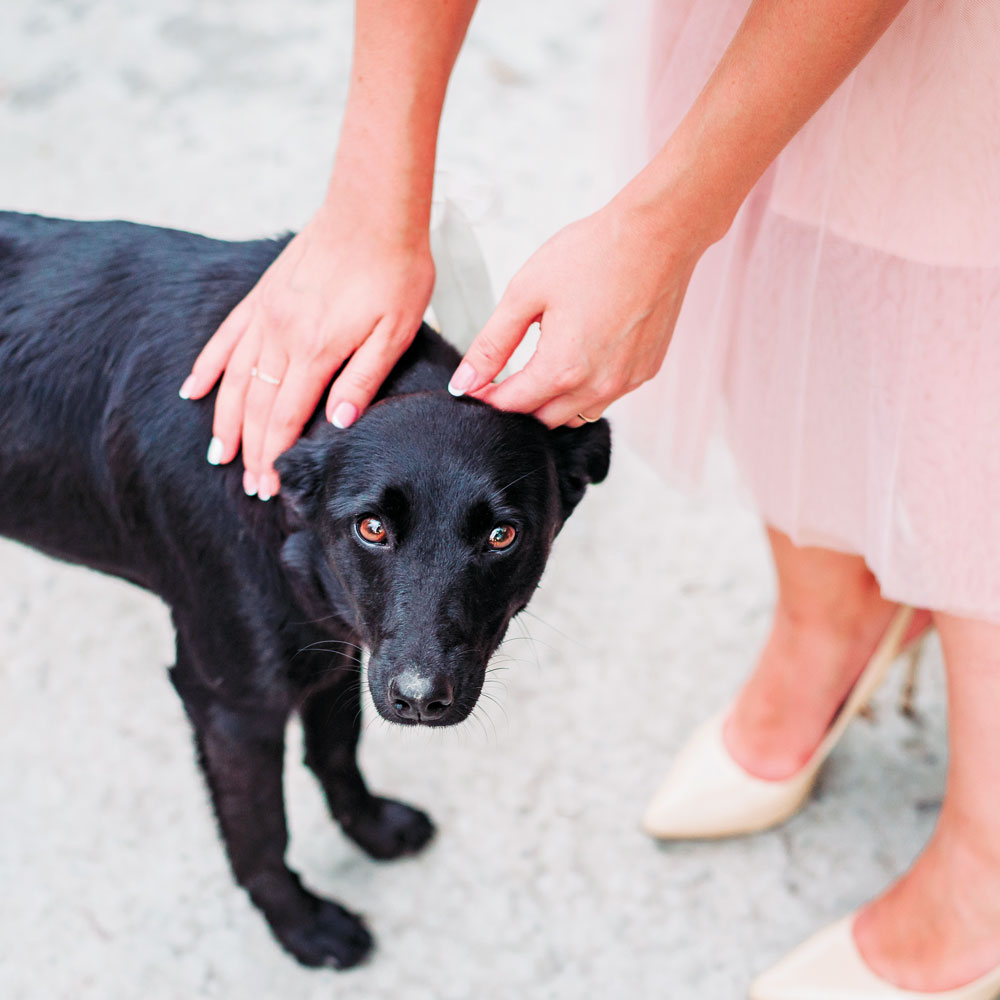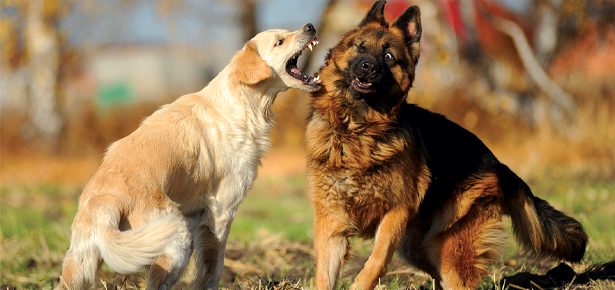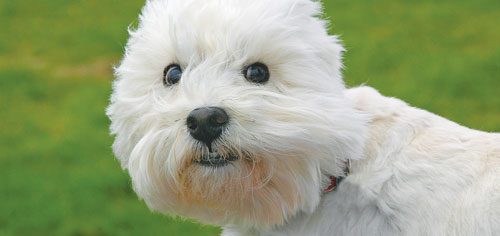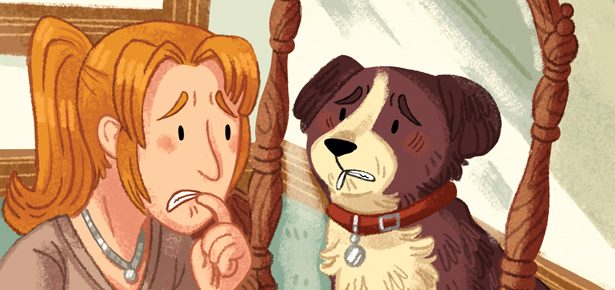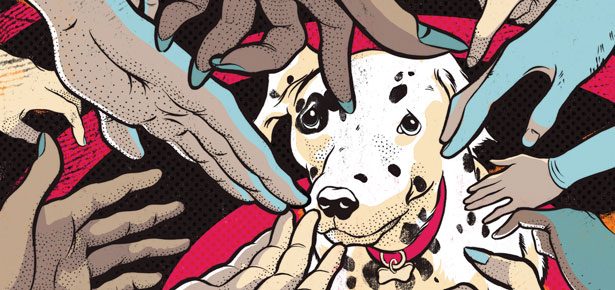
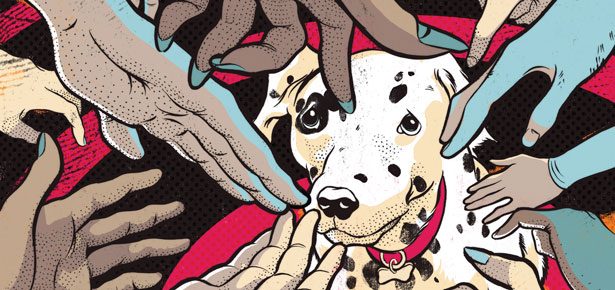
Dog Greetings Gone Wrong
A dog trainer/behaviourist asks, when did we lose the aptitude to greet dogs?
No one seems to know how to greet a dog anymore. Every time I see a person gleefully crouch down to someone’s whale-eyed, tail-down Lab mix or puffed-up Jack Russell, look them in the eye, then reach out a quavering hand, I want to scream. What is up with this? When did we lose the aptitude to greet dogs? I want to talk about this, not only from a practical standpoint, but from a cultural perspective—what it means about us, and our dogs.
Dogs have become conversation pieces, and as such, the centers of attention, especially when out with their owners, at the park or café, or on daily walks. When a person appears with a dog, it is almost mandatory for others to fawn all over it, as if it were a newborn cherub in a stroller, or else some canine incarnation of Justin Bieber. It almost seems compulsory that one pay reverent homage to someone’s dog in order to honour its owner’s beneficence.
It’s hooey. The truth is, most dogs are not body-wagging Golden Retrievers in love with every stranger they see, but instead family-centric, loyal creatures who are almost always initially reserved around strangers. And there is nothing wrong with that. It’s normal. They are programmed with default reservation, because it’s their job to protect and serve the tribe. Period.
Of course, some dogs are more reserved than others, either by breed, history, personality, or a combination of all these. Others, because of poor socialization, lack of training and low confidence, will also be more apt to worry. But, by and large, all dogs need time to process a stranger and see if the new person meets with owner approval. Once they decide that the stranger is acceptable to the owner, all is well.
But most people never let this initial judgment occur. Instead, they dive right into the dog, crouching, pointing, kneeling, reaching, talking baby talk, staring—everything I would do to get a dog to bite me. How did this become the status quo?
For the record, you do not kneel down or bend over and offer your outstretched hand to a strange dog. Ever. All she knows is that someone outside of her tribe is trying to touch her, period. That dog doesn’t care what your hand smells like. What is she supposed to compare it to, anyway? Some stock scent library of well meaning, philanthropic people?
I often see this scenario played out in front of supermarkets, cafes, and storefronts, with tethered dogs whose owners are inside shopping. People going in or out feel obligated to greet the dog, or, worse yet, have their kids greet the dog. And they have of course taught their children the same dysfunctional greeting procedure, nearly guaranteeing their kids gets nipped, either on the outstretched hand, or in the face. Even with the owner present, it is folly to greet a dog in this fashion, unless you have self-destructive tendencies.
Image: Ira_Shpiller/bigstock.com
Was this incorrect greeting methodology taught to us as kids, along with other inanities such as “duck-and-cover,” or “healthy” tanning? If so, I don’t recall. In any event, whoever endorsed this method of dog greeting certainly didn’t know much about dogs.
The right way to greet a strange dog is not at all. That’s right; ignore the dog completely, even if it seems friendly and open to it. Plenty of dogs give mixed signals with tails, ears, and body posture; I’ve had smiling Border Collies, Corgis, Samoyeds, spaniels—all manner of “happy” looking pooches try to bite the blood out of me, all the while projecting mock affability.
Yes, there are dogs whose intent is clear; that five month-old retriever with the serpentine body wag, or the thirteen year-old Gandalf-like Springer mix who keeps sweetly nosing his saliva-soaked tennis ball at you—they are pretty easy to read. But as a general rule, just ignore the dog, and greet the owner first. Don’t even look at the dog.Just shake the owner’s hand, strike up a conversation, avoid wild gesticulations, and let the dog sniff your leg and watch the proceedings. Very quickly it will discern that you are okay, and that you have two dogs at home with bad breath who rolled in poop the day before. Once that happens, you’ll see the dog’s body posture relax. She will wag, smile, try to take part in the greeting, maybe even nudge into you for a pat on the head. A casual scratch and a low key “good girl” is all you’ll need to guarantee a future of safe greetings.
Don’t go overboard, even if the dog seems open to it. At this stage, you’re okay with polite interaction, not roughhousing, manic rubbing, or kooky, frenetic vocalizations. Push an insecure dog too fast, and it will react defensively. Just keep it low key, the same way a dominant dog would act if greeted by a subordinate dog. Be calmly indifferent. Be cool.
If you see a lone, tethered dog, just leave it be. Respect his right to reservation. You needn’t prove to the world that you are Doctor Doolittle; it’s just not worth it. At the very least, wait for the owner to appear, talk to him or her, then let nature take its course. Keep a few cookies in your pocket for casual dropping. But never think you have an obligation to be a dog ambassador.
More importantly, teach your children to do the same. Of the five million reported dog bites that occur in the U.S. every year, the majority of them happen to kids under the age of twelve, due in great part to us teaching them the crazy “hand reach” method of dog salutation.
With regard to loose dogs wandering the neighborhood, use your best judgment as to whether or not they need help. But realize that, even if lost, a strange dog will likely mistrust you, and perhaps bite if someone tries to corral or capture him. And if you see a group of bully dogs with switchblades and leather jackets coursing around, stay calm, don’t run, and do not make eye contact. Move steadily to your objective. If their intent is clearly aggression, jump atop a car with your dog, or grab a trash can for defense. Yell out for help, call 911, and pretend to be more daunting than you are. Never openly confront, unless you have no options left. Carry a few cookies or a tennis ball and toss them into the bushes to distract the brutes. If you walk your dog in an area where strays often carouse, consider carrying pepper spray, a cane or umbrella, or something for defense. Or, perhaps, be squired through the neighbourhood by a brace of 180-pound, well-trained Harlequin Great Danes.
Join the newsletter and never miss out on dog content again!
"*" indicates required fields
By clicking the arrow, you agree to our web Terms of Use and Privacy & Cookie Policy. Easy unsubscribe links are provided in every email.
